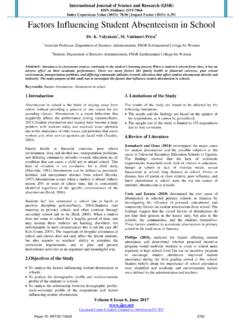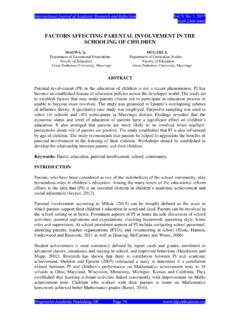Transcription of Factors That Influence Learning by English Language ...
1 Factors that Influence Learning by English Language Learners (ELLs). Kendall Hanus Abstract Current research with English Language learners (ELLs) indicates that there are a number of Factors that Influence students' success in Learning English as an additional Language . Teachers and parents both have different roles in educating and supporting students on their voyage to Learning another Language . Many Factors contribute to students' achieving academic success while Learning a new Language . For the majority of English Language learners (ELLs), a new Language is just one component of adapting and integrating into an educational system within a new society and country. Not only do they have to learn quickly to survive in their daily lives, but they also have to adjust to life in a school environment wherein their native Language is not spoken.
2 Some of the challenges include different behavioural and academic expectations, new social customs, and different cultural values. Teachers and parents Influence various parts of a student's life, and therefore success is attributable to different Factors . Parents have an important role in terms of motivation and educational expectations, as well as socio-economic status. However, it is teachers who create positive teacher-student relationships in classrooms that are culturally inclusive, collaborate with other mainstream educators, and differentiate instruction and assessment to meet student needs. Ultimately, in order for ELLs to have academic success, it is important that parents, teachers, and students work together to create an optimum Learning environment and opportunities for student achievement.
3 Parents have critical roles in terms of motivating their children to learn and to want to improve their Language skills and proficiency. While extrinsic and intrinsic motivation are important for children's success, motivation from parents is a separate form of motivation that has a more direct and positive Influence on student achievement (Butler, 2014). If parents make it clear that education is important and that Language skills and proficiency are desired, children are more likely to be motivated to achieve these goals. Parents' beliefs about their children's abilities and strengths significantly affect children's motivation and their own beliefs about what they are capable of academically (Butler, 2014). If parents support their children's Language Learning at school and also at home by facilitating Language Learning opportunities, children are more likely to achieve success sooner.
4 These activities could be in English or in their native Language , because strengthening one Language benefits the development of all other languages by strengthening core Language proficiency (Aro & Mikkila-Erdmann, 2014). Parents'. expectations and their abilities to motivate their children are important for Language Learning , but parents' socio-economic status also influences students' ability to learn. Socio-economic status can Influence academic expectations, school resources, and societal stereotypes. Families that have a higher socio-economic status tend to have higher academic expectations in regards to college and university for their children, which can affect students' attitudes toward their own abilities and future (Aro & Mikkila-Erdmann, 2014).
5 They can also provide their children with resources and opportunities that families from a lower socio- economic status may not be able to afford. Many students of lower socio-economic status have lower self-esteem and confidence when it comes to education, because they fear that they will not have the same opportunities for success in the future. Typically, students from lower socio- economic status also attend low-income schools that may be old and run-down, lack extra- curricular activities and resources, or exude a negative climate (Chu, 2011). Due to the lower socio-economic status, some EL families are more transient because they move due to changes in jobs, different housing options, or opportunities to be closer to family; however, their transience causes interruptions in education and, hence, Learning gaps (Rance-Roney, 2009).
6 BU Journal of Graduate Studies in Education, Volume 8, Issue 2, 2016 19. These Learning gaps affect not only students' academic performances but also their feelings of confidence, capabilities, and attitudes toward Learning . Therefore, while parents are critical Factors in their children's Learning with respect to motivation, academic expectations, and socio- economic status, teachers determine what takes place in the classroom. It is critical that teachers create positive teacher-student relationships because many ELLs depend more on their teachers for academic support than on their parents (Sung, 2014). In some circumstances, parents value education but lack the academic background or Language skills to help their children with the content or assignments (Chu, 2011).
7 Not only are EL. teachers responsible for Language acquisition and skills, but they are also instrumental in helping students to adjust to the differences in culture and social behaviours. Cultural expectations and beliefs about teachers and students vary, and teachers need to be cognizant of these so that they can bridge the gaps. If students feel safe because they trust their teacher, they will share opinions and ideas, ask questions, and learn new concepts more readily. Positive relationships with teachers improve students' confidence, self-efficacy, and engagement in Learning . If students perceive teachers to be encouraging, supportive, and interested in the content being taught, students are more likely to become engaged and motivated to strengthen their Language skills independently (Fukuda & Yoshida, 2013).
8 Although creating positive teacher-student relationships is the cornerstone of Learning , teachers are also responsible for ensuring that ELLs feel comfortable and supported by their peers. Teachers need to create classroom climates that are culturally inclusive and supportive, so that ELLs will take risks with the Language and not be afraid of making mistakes. A culturally inclusive classroom affects ELLs' progress and skill development because students must feel accepted before they will engage socially. If students are not comfortable, they are more likely to lose interest and to become disengaged in their Learning (Talandis & Stout, 2015). In classrooms wherein students feel safe, comfortable, and valued, they openly share ideas and become accountable for their Learning .
9 Vygotsky's belief that Learning occurs when there is social interaction between more and less knowledgeable people (Yoon, 2012) applies to ELLs who feel comfortable with their peers. Encouraging ELLs to share their experiences, cultural perspectives, beliefs, and values motivates students to learn from each other and brings them closer together in supportive and meaningful ways. Teachers need to foster social interaction between ELLs and their native English speaking peers because ELLs acquire more Language skills, more linguistic patterns, and also more social and academic knowledge from those peers (Sung, 2014). In culturally inclusive classrooms and positive Learning communities, students perform better academically, increase self-esteem, and develop positive interpersonal relationships with students from all cultural and racial groups (Chu, 2011).
10 While positive teacher-student relationships are essential, EL teachers also need to collaborate with mainstream teachers, in order to ensure that ELLs' needs are met in all of their classes. Mainstream teachers often have limited training in teaching Language learners and benefit from extra support and instruction on how to integrate Language instruction effectively in the classroom (Coelho, 2012). Many mainstream teachers also lack the training, knowledge, and experience to teach specific reading and literacy skills, which leads to inadequate literacy instruction and lower ELLs' reading achievements (Brown & Doolittle, 2008). Open communication between mainstream and EL teachers produces timely diagnosis and strategic interventions (Garcia & Kim, 2014).















